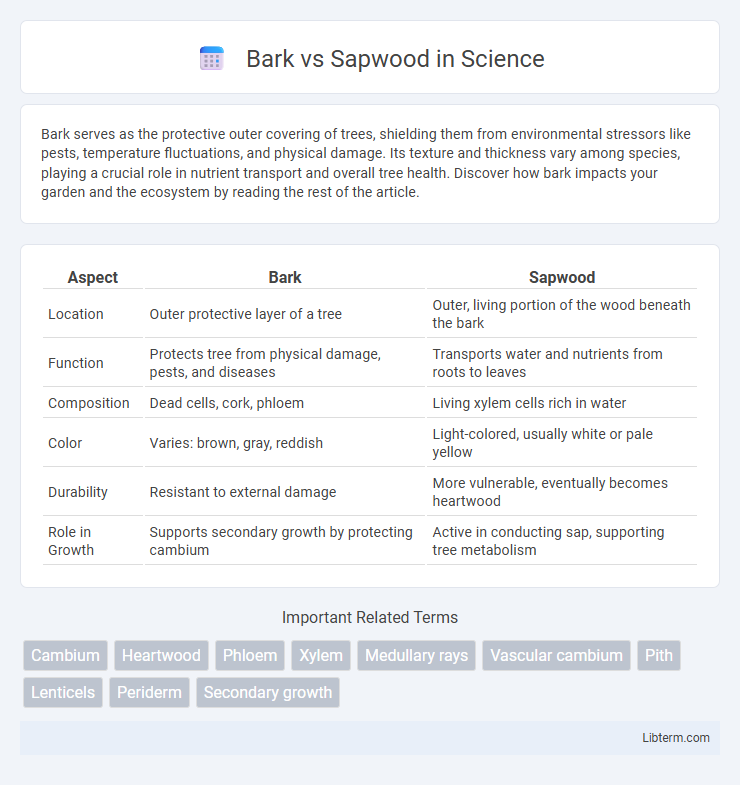Bark serves as the protective outer covering of trees, shielding them from environmental stressors like pests, temperature fluctuations, and physical damage. Its texture and thickness vary among species, playing a crucial role in nutrient transport and overall tree health. Discover how bark impacts your garden and the ecosystem by reading the rest of the article.
Table of Comparison
| Aspect | Bark | Sapwood |
|---|---|---|
| Location | Outer protective layer of a tree | Outer, living portion of the wood beneath the bark |
| Function | Protects tree from physical damage, pests, and diseases | Transports water and nutrients from roots to leaves |
| Composition | Dead cells, cork, phloem | Living xylem cells rich in water |
| Color | Varies: brown, gray, reddish | Light-colored, usually white or pale yellow |
| Durability | Resistant to external damage | More vulnerable, eventually becomes heartwood |
| Role in Growth | Supports secondary growth by protecting cambium | Active in conducting sap, supporting tree metabolism |
Introduction to Bark and Sapwood
Bark serves as the protective outer layer of a tree, shielding the inner tissues from environmental damage and pests. Sapwood is the younger, outermost wood beneath the bark, responsible for transporting water and nutrients from the roots to the leaves. Understanding the distinct functions and structures of bark and sapwood is essential for studying tree health and growth.
Definition and Basic Structure
Bark is the outer protective layer of a tree composed of an outer dead layer called cork and an inner living layer called the phloem, responsible for nutrient transport. Sapwood, also known as xylem, is the younger, outer part of the secondary wood that conducts water and minerals from roots to leaves. While bark serves as a protective barrier, sapwood provides structural support and essential hydration to the tree.
Composition Differences
Bark primarily consists of cork cells, phloem tissue, and protective compounds like suberin, serving as an outer protective layer against environmental damage and pathogens. Sapwood is composed mainly of xylem vessels and parenchyma cells, actively involved in water transport and nutrient conduction within the tree. Unlike bark, sapwood contains living cells that facilitate sap flow, while bark is largely dead tissue providing insulation and defense.
Functions of Bark
Bark serves as a protective layer for trees, shielding against physical damage, pathogens, and extreme weather conditions. It also facilitates the transport of nutrients and water, while aiding in gas exchange through lenticels. Unlike sapwood, which primarily conducts water and stores nutrients, bark plays a crucial role in defense and external support.
Functions of Sapwood
Sapwood functions primarily as the active, living part of a tree's xylem, responsible for the efficient conduction of water and minerals from roots to leaves. It also stores essential nutrients and provides structural support while facilitating the transport of organic compounds produced during photosynthesis. Unlike bark, which protects and insulates the tree, sapwood plays a vital role in maintaining the tree's physiological processes and growth.
Role in Tree Growth and Health
Bark protects the tree from external damage, pests, and diseases, acting as the tree's first line of defense crucial for overall health. Sapwood transports water and nutrients from roots to leaves, supporting vital processes like photosynthesis and growth. Together, bark and sapwood ensure the tree's structural integrity and sustain its metabolic functions essential for development.
Importance in Timber and Wood Industries
Bark serves primarily as a protective layer, shielding the timber from pests, diseases, and environmental damage, which is vital for maintaining wood quality during processing and storage. Sapwood conducts water and nutrients, and its higher moisture content affects drying times and susceptibility to decay, influencing decisions in timber grading and treatment. Understanding the differences between bark and sapwood ensures efficient utilization of wood resources, optimizing durability and performance in construction and manufacturing.
Ecological Significance
Bark serves as a protective barrier against pathogens, insects, and environmental stresses, playing a crucial role in maintaining tree health and supporting forest ecosystems. Sapwood functions as the primary conduit for water and nutrients from roots to leaves, facilitating vital physiological processes and sustaining overall tree growth. The interaction between bark and sapwood enhances a tree's resilience against environmental challenges, promoting biodiversity and ecological stability within forest habitats.
Bark vs Sapwood: Key Distinguishing Features
Bark is the outer protective layer of a tree, composed of cork and phloem tissues that shield the tree from environmental damage and pests, whereas sapwood is the inner, living layer responsible for transporting water and nutrients from the roots to the leaves. Bark is generally rough and rigid, often containing varying textures and colors, while sapwood appears lighter in color, softer, and more porous due to its role in fluid conduction. Key distinguishing features include bark's function as a protective barrier versus sapwood's role in sustenance and growth, as well as their distinct anatomical positions and textures within the tree structure.
Conclusion: Choosing Between Bark and Sapwood
Bark serves as a protective outer layer rich in tannins that guard trees against pests and disease, while sapwood functions as the vital conduit transporting water and nutrients. When selecting between bark and sapwood for practical use, consider bark's durability and resistance to decay versus sapwood's structural strength and moisture content. Optimal application depends on whether the priority is protective qualities or mechanical support in woodworking, landscaping, or craft projects.
Bark Infographic

 libterm.com
libterm.com